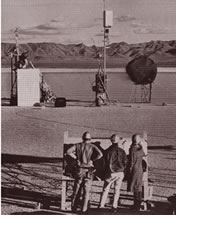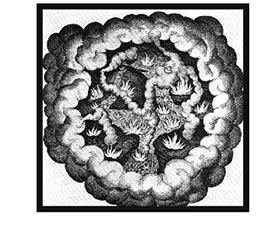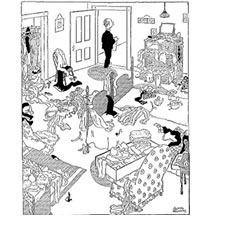01 "Study for the End of the World" art that destroys itself
- a piece by the Swiss sculptor Jean Tinguely awaiting its moment in
the desert, 1960.
02 The image of Chaos from Robert Fludde's Utriusque, cosmi...
1617, engraved by de Bry in Oppenheim (1617)
03 The American illustrator Gluyas Williams draws Chaos in the man
looking for a handkerchief.
 Change and Chaos , a symposium at the University of California 1971 titlepage Change and Chaos , a symposium at the University of California 1971 titlepage
KAOS ; studies in disorder. IMAGES
Chaos is separated into the Four Elements.
"that confused mass of elemental substances supposed to have existed
before God reduced creation into order." Brewer' Dictionary of
Phrase and Fable.
"a gaping void, yawning, gulf, chasm,, or abyss" 1667
"the formless void of primeval mater" 1531
"a state of utter confusion and disorder.." 1606
" an amorphous lump..." 1593
"chaos" from a greek root, "to gape"
The course has tried to define the subject of its activities by defining
what it is not. In the second term of the course Professor Aaron Scharf
held a two day session on aspects of the non-sequential. This documentation
is dedicated with affection to his memory. George Hardie, John Vernon
Lord and Chris Mullen, had all been taught by this remarkable man with
the liveliest and most optimistic of minds. He is much missed.
MYTHOLOGY 1. "Nun (or Nu) is Chaos, the primordial
ocean in which before the creation lay the germs of all things and all
beings. The Texts call him 'the father of the gods' but he remains a
purely intellectual concept and had temples nor worshippers. He is sometimes
found represented as a personage plunged up to his waist in water, holding
up his arms to support the gods who have issued from him." The
Ennead of Heliopolis and the family of Osiris, Larousse Encyclopaedia
of Mythology, Paul Hamlyn London 1969.
" because of a false derivation from a word meaning to pour, Chaos
was considered to mean the confused and unorganised mass of the elements
scattered throughout space...." Larousse.
"the first principle of Creation was Cronos or Time from which
came chaos which symbolised the infinite, and ether which symbolised
the finite. Chaos was surrounded by night which formed the enveloping
cover under which, by the creative action of the Ether, cosmic matter
was slowly orgnaised." Larousse on Orphic interpretation of the
Creation, Greece.
MYTHOLOGY2. see under Janus, the god of beginnings.
"When the elements separated, chaos took on the form of Janus :
his two faces represented the confusion of his original state..... He
is normally represented with a double face or as an older man with a
beard...."
BIBLICAL PROPHESY "I beheld the earth and it was
without form and void, and the heavens and they had no light. I beheld
the mountains and they trembled, and all the hills moved lightly. I
beheld and there was no man, and all the birds of the heavens were fled.
I beheld and the fruitful place was a wilderness and all the cities
thereof were broken down..... A noise shall come even to the ends of
the earth.... Evil shall go forth from nation to nation, and a great
whirlwind shall be raised up from the coasts of the earth. And the slain
of the Lord shall be that day from one end of the earth unto the other
end of the earth; they shall not be lamented, neither gathered, nor
buried ; they shall be dung upon the ground." Jeremiah 5, 23-6,
and 25 31-3.
THE ENGLISH REVOLUTION 17th Century Radicalism "
The world travails perpetually, every one is swollen full, big with
particularity of interest... labouring to bring forth some one thing,
some another, and all bring forth nothing but wind and confusion....
There is a set time for every purpose, under heaven : vanity hath its
time also ... It may be that I am now casting stones against the wind
(that is but vanity), I have lived to see an end to all perfections.."
Joseph Salmon, Heights in Depth and Depths in Heigths, 1651, the recantation
of a disillusioned Ranter. Hill beneath.
"Day + 9 : Estimate 100,000 refugees coming from West Midlands
- most injured/shocked/irradiated. Consider disinfectant in Rugby/Coventry
area to avert disease. Liase with military for aircraft for spraying.
Control of refugees in the west of the county impossible at this stage...advise
public on measures being taken to alleviate rioting and looting. Advise
public with regard to disposal of dead bodies. Advise populace not to
leave their areas." Exercise Square Leg, 9 days after a nuclear
strike on Warwickshire. War Plan UK , see beneath.
Compilation sequences for Chaos
The sequence of films does pretend to a narrative. You may think there
is a pattern. If this is so, it seeks to project a fusion of balance
and disorder, with associated extremes of chaos and repressive ordering
of society.No sections will offend but are chosen to make particular
points about this fusion and the consequences when the extremes are
reached.
Find whatever items on the list you can.
Films suggested for your studies ;
1. Frederick Wiseman's documentary Hospital, one
of a series of studies of American institutional life. Here a young
man is treated after accepting a curious pill from a man in the
park. (1970)
2. The Bone Room from The Texas Chainsaw Massacre,
directed by Tobe Hooper and a striking study of oppressive atmospheres.
A girl on her way to a funeral and looking for her friend, wanders
into a house with strange rooms. (1974)
3. L'Enfant Sauvage, directed by F.Truffaut. The
Wild Boy is taught to write his name after months of perseverence
by a doctor determined to wrest him from the bestial. (1969)
4. The Third Man, directed by Carol Reed, the crook
Harry Lime who most people in post-war Vienna assumed to be dead,
is lured by the British Army to a cafe. His girl friend warns him
and he escapes through the bombed buildings to the sewers. (1949)
5. Laurel and Hardy, The Sons of the Desert, directed
by Hal Roach. Stan tells the truth about their attendance at the
Convention of the Sons of the Desert, while Ollie tries to bluff
his way out. (1934)
6. 1941, directed by Stephen Spielberg, an attempt
to resurrect the cornball comedies of the thirties with particular
emphasis on the destruction of property. Based on a true account
of hysterical American civilian reaction to a rumour that a Japanese
submarine had been spotted on the West coast. (1979)
7. Dark Star, the section submitted by the director
John Carpenter as a student work at the UCLA Film School, three
seedy space travellers on a sort of space steamer. Pinback has taken
a cute alien as ship's mascot and tries to feed it. ((1974)
8. Koyaanisqatsi, (a state of life that calls for
another way of living) directed by Godfrey Reggio, a compilation
of footage depicting the environmental decline of the planet, to
music by Philip Glass. Buildings rot and decay, then a sequence
of destruction. Originally funded as Public Information and Teaching
film. (1983)
9. The Empire of the Sun, directed by Spielberg,
a young boy in Shanghai is separated from his family when the Japanese
invade. Fooling at the window he believes he has started the whole
invasion. He gets back to the family home, an exported version of
the Surrey stockbroker belt, to find the area deserted and he lives
off what he can find. (1987)
10. Ran, directed by Akira Kurosawa, that director's
highly pessimistic version of Shakespeare's King Lear set in the
Japan of the Middle Ages.. The Palace is stormed by an enemy and
Ran's attendants are slaughtered. (1985)
11. Walkabout, directed by Nicholas Roeg, the dense
opening section contrasting the urban society of Australia with
the open vacuum of the Outback. The rituals of the city dweller
are shown, education of diction, going to work, the family are shoiwn
as a unit in a flat and break under the strain. (1970)
12. An American in Paris, directed by Vincente
Minelli, the precision dance number, I'll Build a Stairway to Paradise,
the totality of designed entertainment before computer controlled
lightinmg. (1951)
13. Full Metal Jacket, directed by Stanley Kubrick,
the beginning of the recruits' training as Marines. The geometry
of uniformity and the richness of declamatory prose. (1987)
14. Brighton Rock, directed by Carol Reed, the
coy disclaimer at the beginning of the film revealing the seediness
of the town's life and culture. (1947)
15. Playtime, Jacques Tati's final masterpiece;
in pursuit of an official in charge,Monsieur Hulot is lured into
a modern office and finds it difficult to establish a sense of direction.
((1968)
16. Zombies, Dawn of the Dead, the best of Romero's
trilogy sees the Undead trying to reclaim a hyper-market, while
the last representatives of capitalism hide out in the manager's
office. The Undead have an essential innocence and a charming absurdity.
Nothing gross will be shown. (1979)
BOOKLIST
1. Historical, Spiritual and Mythological References.
Bryan Wilson, Magic and the Millenium , Paladin London
1973 the recurring human tendency to seek the imposition of outside
powers to calm the chaos within.
The Holy Bible The Book of Revelations Genesis (King
James Version),
Enmmanuel L.Ladurie Montaillou Penguin London 1978
life in a medieval village, the Albigensian heresy. Religion and magic.
Christopher Hill The World turned upside down Penguin
London 1974 Ranters, Levelers, Muggletonians, radical ideas of re-structuring
society in seventeenth century.
Humphrey Jennings Pandaemonium Deutsch 1985
2. Psychological implications
Thomas Ssasz The Manufacture of Madness Paladin London 1977 the need
for society to create 'the outsider' as a focus for hatred and aggression,
to help bind that Society together, here in the context of the persecution
of witches.
Elias Canetti Crowds and Power; the account of the
mental illness of Judge Schreber.
Evelyn Waugh The Ordeal of Gilbert Pinfold ; an account
of one man's mental collapse into delusion and the hearing of hostile
voices.
Charlotte Perkins Gilman The Yellow Wallpaper 1892
an oppressed woman's obsessive image fantasies while locked in a room.
Maurice Sendak Where the Wild Things are various
editions. accounts of inductrial revolutions and the destruction of
society and the landscape.
3. . Contemporary References :
Duncan Campbell War Plan UK Burnett 1982 The Truth
about Civil Defence in Britain
Duncan Campbell The Unsinkable Aircraft Carrier Paladin
London 1986 American Military Power in Britain.
John Carey (ed) The Faber Book of Reportage Faber
London 1987
Frank Snepp Decent Interval Penguin London 1980 the
fall of Saigon, Vietnam War, April 1975
John Hersey Hiroshima 1946 Penguin Special
4. Chaos and the Visual Arts.
exhibition catalogue Creation, Modern Art and Nature
Scottish Gallery of Mod 1984
Andrew Wilton Turner and the Sublime British Museum
London 1981
exhibition catal. Max Beckmann : The Triptychs Whitechapel
1981
D.Mellor Cityscape 1910-1939 Royal Acdemy 1978 essays
on the apocalyptic city.
P.Weiss Kandinsky in Munich 1896-1914 Guggenheim
NY
5. Relevant Films
5.1 Gregory Corso Koyaanisquatsi (the world as imploding
structurte of human beings destroying the planet).
5.2 F.F.Coppola Apocalypse Now , (the end of all
human values and behaviour at the end of the river in Vietnam).
5.3 Fritz Lang Metropolis (the destruction of the
underground workers' city and the Machine).
5.4 Roman Polansky Macbeth (power structures break
down, equivalent response from Nature).
5.5 S.Spielberg Empire of the Sun (a bot lost in
Shanghai after the Japanese invasion).
5.6 A.Kurosawa Ran (the collapse of monarchy and
hope in medieval Japan).
5.7 Kusnetsov Come and See (life in Byelorussia after
the Nazi occupation).
6. Suggested texts for further reading
See particularly, John Carey, the Faber Book of Reportage.
6.1 Charles Dickens, Description of Coketown from Hard Times
1854
6.2 Nathaniel West The Day of the Locust 1939; crowd
scene at a Hollywood premiere.
6.3 Primo Levi The Truce ; Wandering crowds of refugees
in Europe after the fall of Nazi Germany (published with If this is
a Man ).
6.4 J.G.Ballard Empire of the Sun a small boy's perceptions
of his experiences in Shanghai after the Japanese invasion (see film
above)
6.5 E.M.Foster When the Machine Stops (a short story)
6.6 Margaret Freyer An account of the Bombing of Dresden 1944 (Faber
above)
6.7 Patrick Gordon Walker The Liberation of Belsen 1945 (Faber above)
6.8 Marcel Junod Visiting Hiroshima 1945 (Faber above)
6.9 Exercise Square Leg Day by Day account of main events as scheduled
in a Ministry of Defence planning exercise for planning after an atomic
strike on Warwickshire from War Plan UK .
|



















